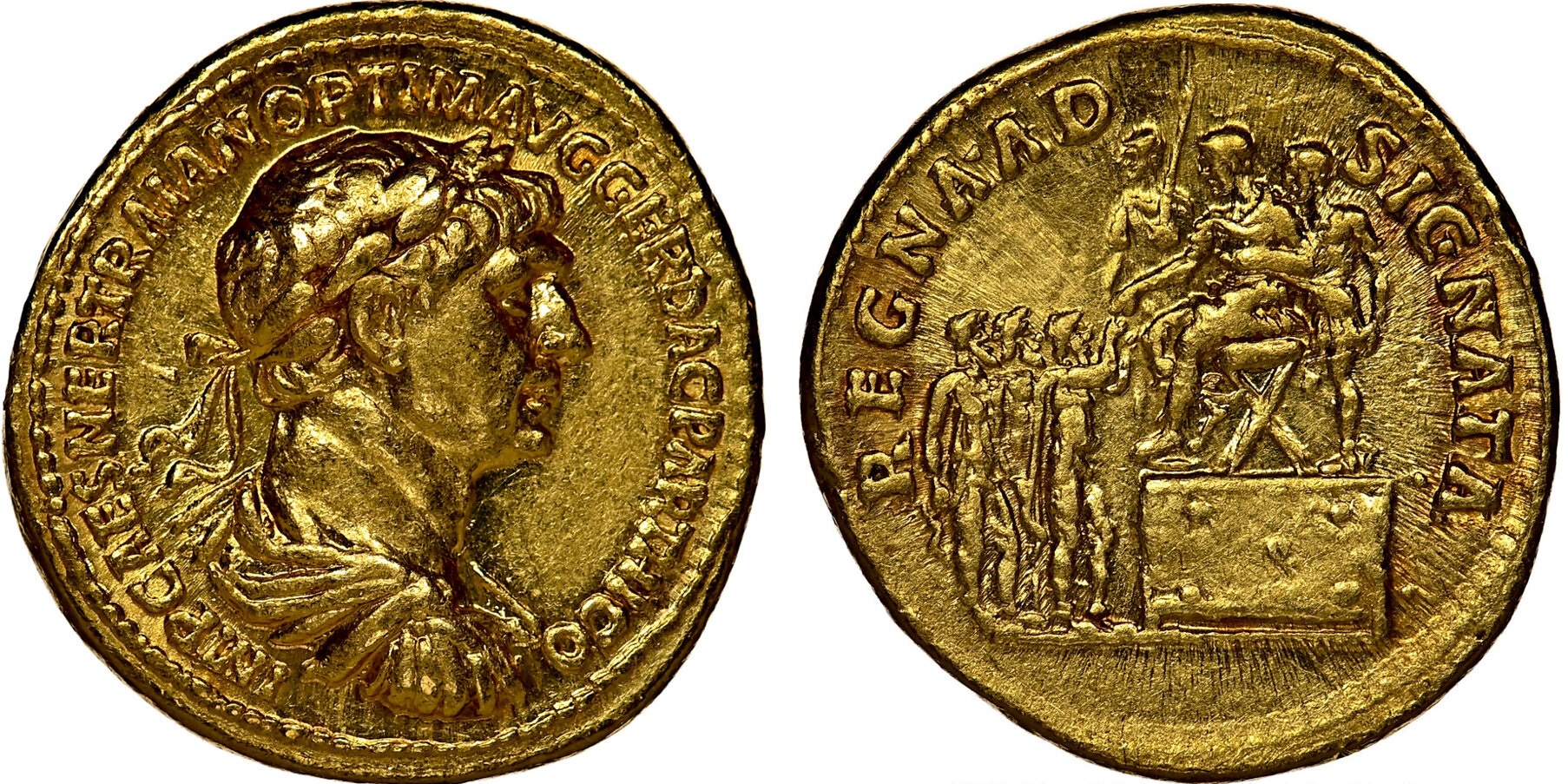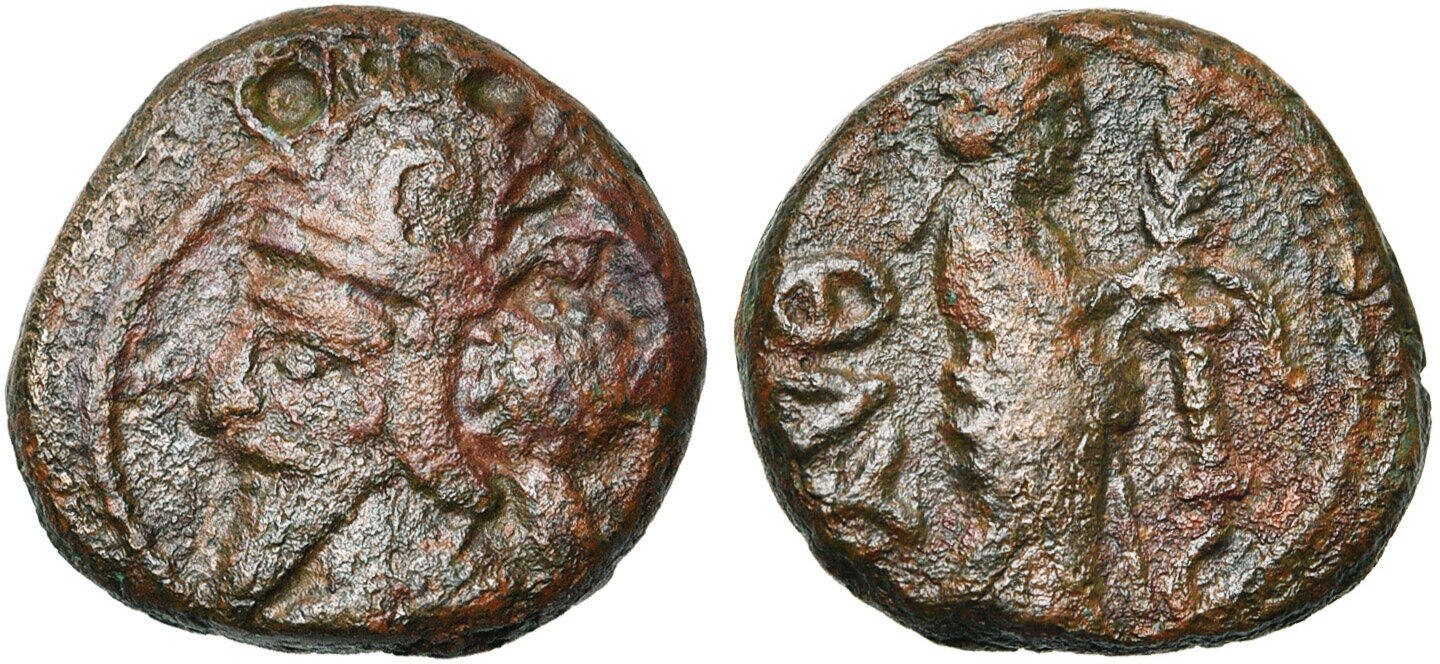1. Overview
Osroes I, also known as Chosroes I or Khosrow I (𐭇𐭅𐭎𐭓𐭅Husrōwxpr), was a significant figure in the Parthian Empire who reigned over its western territories from 109 to 129 AD, with a brief interruption. His rule was largely defined by a persistent internal conflict with Vologases III, who controlled the eastern provinces of the empire. This period of internal strife created an opportunity for the Romans to intervene in Parthian affairs. In 116, Roman Emperor Trajan launched a major invasion, briefly ousting Osroes I and installing his son, Parthamaspates, as a puppet ruler. However, following Trajan's death in 117, Osroes I regained his throne with the support of the Parthian nobility. His reign ultimately concluded in 129 when Vologases III finally succeeded in removing him from power. Numismatic evidence from his reign provides insights into his appearance and has led to scholarly discussion regarding potential connections with another ruler named Osroes of Elymais.
2. Early life and background
Osroes I's rise to power was marked by a challenge to the existing Parthian monarch, initiating a period of internal conflict that would define much of his reign.
2.1. Birth and lineage
Osroes I was a member of the Arsacid dynasty, the ruling house of the Parthian Empire. While specific details about his birth are limited, his actions indicate his strong claim to the throne within the royal family. He was a son of Vonones II and a brother of Pacorus II and Vologases II.
2.2. Claim to the throne
In 109, Osroes I initiated a revolt against the reigning Parthian king, Pacorus II, aiming to seize the throne for himself. This act marked the beginning of a prolonged civil war within the Parthian Empire. Following Pacorus II's death, Osroes I managed to establish control over the western part of the empire, including the strategically important region of Mesopotamia. This left the eastern provinces under the control of his rival, Vologases III, who had declared himself king in the east around 110.
3. Reign and internal conflict
Osroes I's reign was characterized by his governance of the western Parthian territories and an ongoing power struggle with Vologases III, who commanded the eastern half of the empire.
3.1. Rule over Western Parthia
After successfully establishing his authority in the western regions, Osroes I governed territories that included Mesopotamia. During this period, the Parthian Empire was effectively divided, with Osroes I ruling from the west and Vologases III maintaining his base in the eastern provinces. This internal division significantly weakened the empire, making it vulnerable to external pressures.
4. Roman intervention and invasion
The internal strife within the Parthian Empire under Osroes I created a critical opportunity for Roman expansion, leading to a major invasion by Emperor Trajan.
4.1. Armenian crisis and Trajan's invasion
In 113, Osroes I directly challenged the existing peace agreement with the Roman Empire by violating the Treaty of Rhandeia. This treaty had previously established a delicate balance of power in Armenia, a buffer state often contested by both empires, stipulating that an Arsacid prince would rule Armenia as a Roman vassal. Osroes I deposed Axidares, a brother of Vologases III, from the Armenian throne and appointed his nephew, Parthamasiris (who was also Axidares's brother), as the new king of Armenia. This unilateral action, which strengthened Parthian control over Armenia, provided Roman Emperor Trajan with a convenient pretext to invade the Parthian domain. Trajan exploited the ongoing civil war between Osroes I and Vologases III to his advantage. In 114, Trajan conquered Armenia, transforming it into a Roman province and killing Parthamasiris.
4.2. Roman conquest and installation of Parthamaspates

In 115, Trajan advanced into Babylonia. Osroes I, along with his brother Mithridates IV and his son Sanatruces II, attempted to resist the Roman invasion but were defeated. By 116, Trajan's forces had captured Seleucia and Ctesiphon, the twin capitals of the Parthian Empire. Trajan's campaign extended as far as the Persian Gulf, where he compelled Attambelos VII, the Parthian vassal ruler of Characene, to pay tribute. Fearing widespread revolt from the Parthian populace, Trajan installed Osroes I's son, Parthamaspates, as a puppet ruler on the throne at Ctesiphon. During this expedition, Trajan also captured a daughter of Osroes I, who remained a Roman captive until a peace treaty was concluded between the two powers in 129. Mithridates IV and Sanatruces II continued to fight against the Romans in Mesopotamia, but Trajan's forces eventually defeated them and declared Mesopotamia a new Roman province. Trajan even crossed the Khuzestan mountains and occupied the city of Susa.
4.3. Restoration of the throne after Trajan's death
Trajan's extensive gains in the East proved to be short-lived. Widespread revolts erupted across all the conquered territories, with the Babylonians and Jews actively pushing the Romans out of Mesopotamia. Additionally, Armenians under Sanatruk posed significant problems for the Roman forces. Following Trajan's death in 117, the Parthian nobility swiftly removed Parthamaspates from the throne and reinstated Osroes I as king. Trajan's successor, Emperor Hadrian, adopted a different policy, renouncing the remaining Roman conquests in the East. Hadrian acknowledged the Treaty of Rhandeia, and a Parthian prince named Vologases I of Armenia became the new king of Armenia, restoring the long-standing arrangement.
5. Confrontation with Vologases III and deposition
The weakened state of the western Parthian Empire after the Roman invasion provided Vologases III with an opportunity to assert his dominance, leading to the final confrontation with Osroes I.
5.1. Continued struggle and final removal
The extensive war with Rome severely weakened Osroes I's position and the western part of the Parthian Empire, which had been directly impacted by the Roman invasion. In contrast, Vologases III's eastern domains remained largely untouched by the Roman campaigns, giving him a significant advantage. This weakened state presented Vologases III with the opportunity to regain the territories that Osroes I had seized from him earlier. During these conflicts, a significant portion of Osroes' territory, including the Atropatene kingdom, came under Vologases III's control. Although Vologases III was also preoccupied with incursions from the Alans, he steadily consolidated his power. In 129, Vologases III finally succeeded in removing Osroes I from power, bringing an end to his long reign and the protracted civil war for control of the Parthian Empire. Osroes I's brother, Mithridates IV, succeeded him and continued the struggle against Vologases III.
6. Coinage and connections

The coinage of Osroes I provides valuable insights into his reign and appearance. On the obverse of his silver coins, Osroes I is depicted with his hair styled in bunches, wearing a diadem. His bronze coins, however, portray him wearing a tiara adorned with hooks and a horn on the side. The style of Osroes I's coins bears a striking resemblance to those of another ruler, Osroes of Elymais, who governed the region of Elymais. This strong similarity has led some scholars to propose that Osroes I of Parthia and Osroes of Elymais might have been the same individual. An alternative theory suggests that the Elymais ruler merely copied the coinage of Osroes I of Parthia.
7. Family
Osroes I had several known family members who played roles in the political landscape of the time. His son, Parthamaspates, was briefly installed as a puppet king by the Romans during Trajan's invasion. Additionally, a daughter of Osroes I was captured by Trajan during his expedition and remained a Roman captive until a peace treaty was established in 129. He also appointed his nephew, Parthamasiris (son of Pacorus II), as king of Armenia. Parthamasiris was also a brother of Axidares.